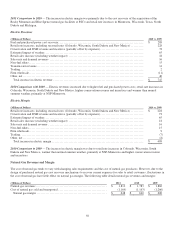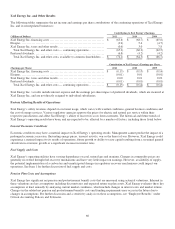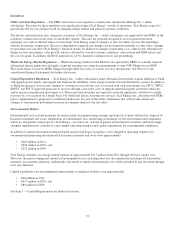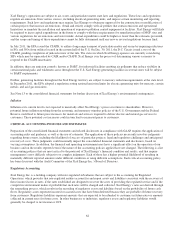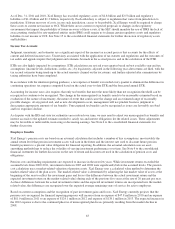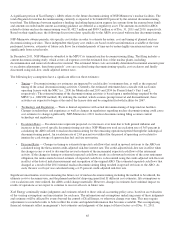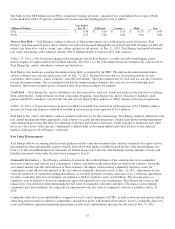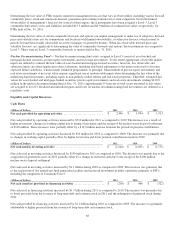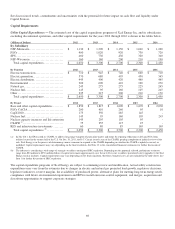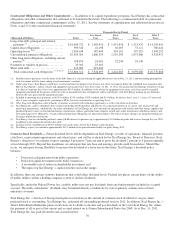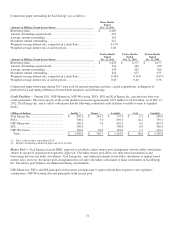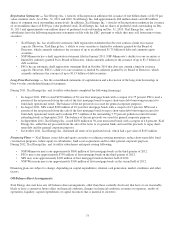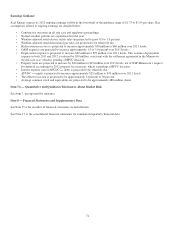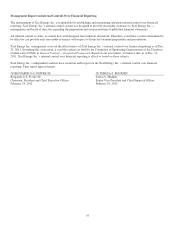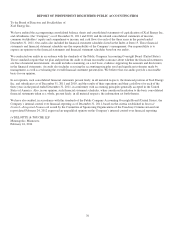Xcel Energy 2011 Annual Report Download - page 76
Download and view the complete annual report
Please find page 76 of the 2011 Xcel Energy annual report below. You can navigate through the pages in the report by either clicking on the pages listed below, or by using the keyword search tool below to find specific information within the annual report.
66
Derivatives, Risk Management and Market Risk
In the normal course of business, Xcel Energy Inc. and its subsidiaries are exposed to a variety of market risks. Market risk is the
potential loss or gain that may occur as a result of changes in the market or fair value of a particular instrument or commodity. All
financial and commodity-related instruments, including derivatives, are subject to market risk. See Note 11 to the consolidated
financial statements for further discussion of market risks associated with derivatives.
Xcel Energy is exposed to the impact of changes in price for energy and energy-related products, which is partially mitigated by
the use of commodity derivatives. In addition to ongoing monitoring and maintaining credit policies intended to minimize overall
credit risk, when necessary, management takes steps to mitigate changes in credit and concentration risks associated with its
derivatives and other contracts, including parental guarantees and requests of collateral. While Xcel Energy expects that the
counterparties will perform under the contracts underlying its derivatives, the contracts expose Xcel Energy to some credit and
nonperformance risk. Though no material non-performance risk currently exists with the counterparties to Xcel Energy’s
commodity derivative contracts, distress in the financial markets may in the future impact that risk to the extent it impacts those
counterparties. Distress in the financial markets may also impact the fair value of the debt and equity securities in the nuclear
decommissioning fund and master pension trust, as well as Xcel Energy’s ability to earn a return on short-term investments of
excess cash.
Commodity Price Risk — Xcel Energy Inc.’s utility subsidiaries are exposed to commodity price risk in their electric and natural
gas operations. Commodity price risk is managed by entering into long- and short-term physical purchase and sales contracts for
electric capacity, energy and energy-related products and for various fuels used in generation and distribution activities.
Commodity price risk is also managed through the use of financial derivative instruments. Xcel Energy’s risk management policy
allows it to manage commodity price risk within each rate-regulated operation to the extent such exposure exists.
Short-Term Wholesale and Commodity Trading Risk — Xcel Energy Inc.’s utility subsidiaries conduct various short-term
wholesale and commodity trading activities, including the purchase and sale of electric capacity, energy and energy-related
instruments. Xcel Energy’s risk management policy allows management to conduct these activities within guidelines and
limitations as approved by its risk management committee, which is made up of management personnel not directly involved in
the activities governed by this policy.
Changes in the fair value of commodity trading contracts before the impacts of margin-sharing mechanisms for the years ended
Dec. 31, were as follows:
(Thousands of Dollars) 2011 2010
Fair value of commodity trading net contract assets outstanding at Jan. 1 ...................... $
20,249 $
9,628
Contracts realized or settled during the period............................................... (10,672) (4,449)
Unrealized commodity trading transactions during the period................................. 10,847 15,070
Fair value of commodity trading net contract assets outstanding at Dec. 31 .................... $
20,424 $
20,249
At Dec. 31, 2011, the fair values by source for the commodity trading net asset balance were as follows:
Futures / Forwards
(Thousands of Dollars) Source of
Fair Value
Maturity
Less Than
1 Year Maturity
1 to 3 Years
Maturity
4 to 5 Years
Maturity
Greater Than
5 Years
Total Futures/
Forwards
Fair Value
NSP-Minnesota
..............
1 $
4,317
$
14,843 $
- $
- $
19,160
PSCo
........................
1 474
790 - - 1,264
$
4,791
$
15,633 $
- $
- $
20,424
1 — Prices actively quoted or based on actively quoted prices.
At Dec. 31, 2011, a 10 percent increase in market prices for commodity trading contracts would increase pretax income from
continuing operations by approximately $0.2 million, whereas a 10 percent decrease would decrease pretax income from
continuing operations by approximately $0.2 million.
Xcel Energy’s short-term wholesale and commodity trading operations measure the outstanding risk exposure to price changes on
transactions, contracts and obligations that have been entered into, but not closed, including transactions that are not recorded at
fair value, using an industry standard methodology known as Value at Risk (VaR). VaR expresses the potential change in fair
value on the outstanding transactions, contracts and obligations over a particular period of time under normal market conditions.


